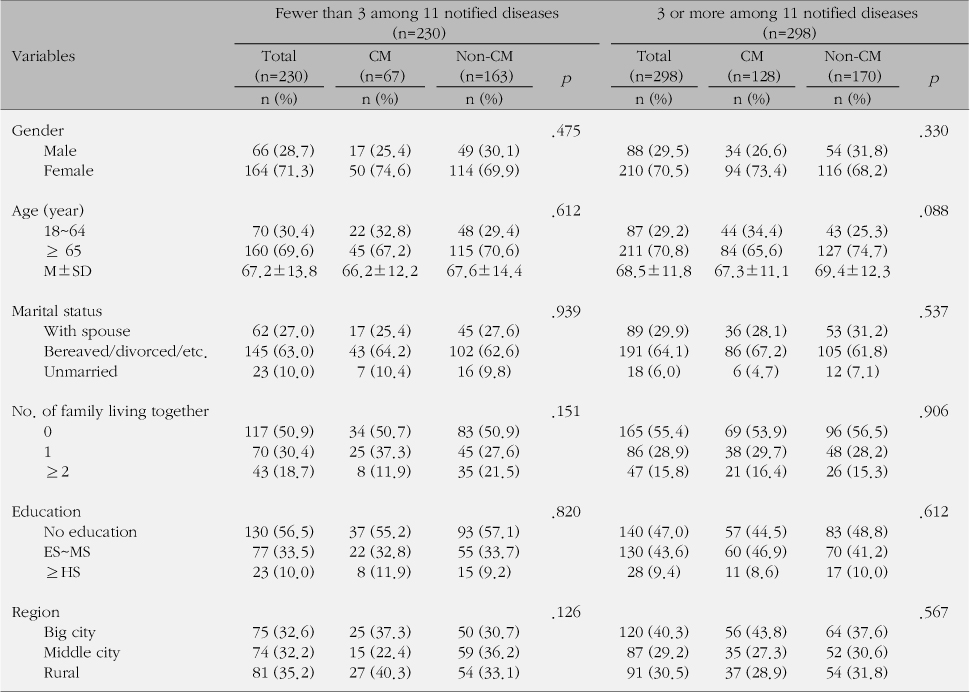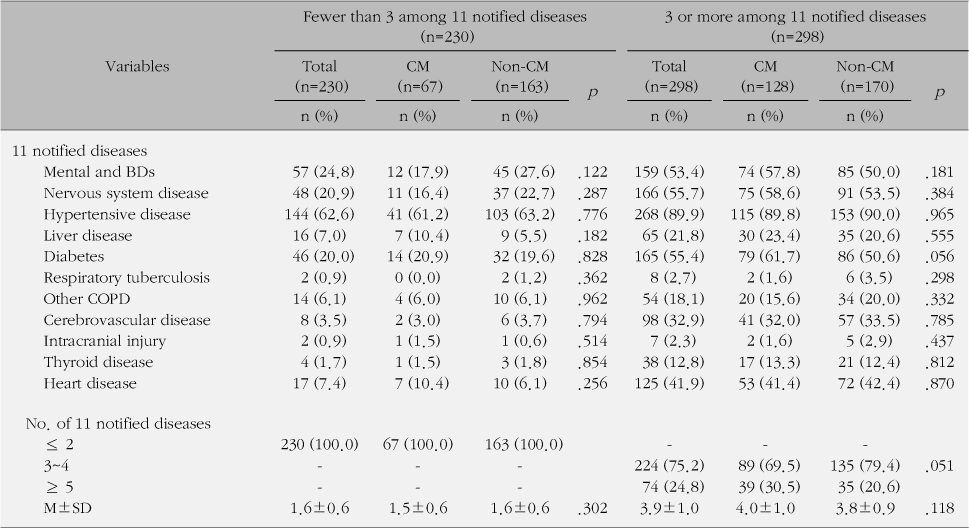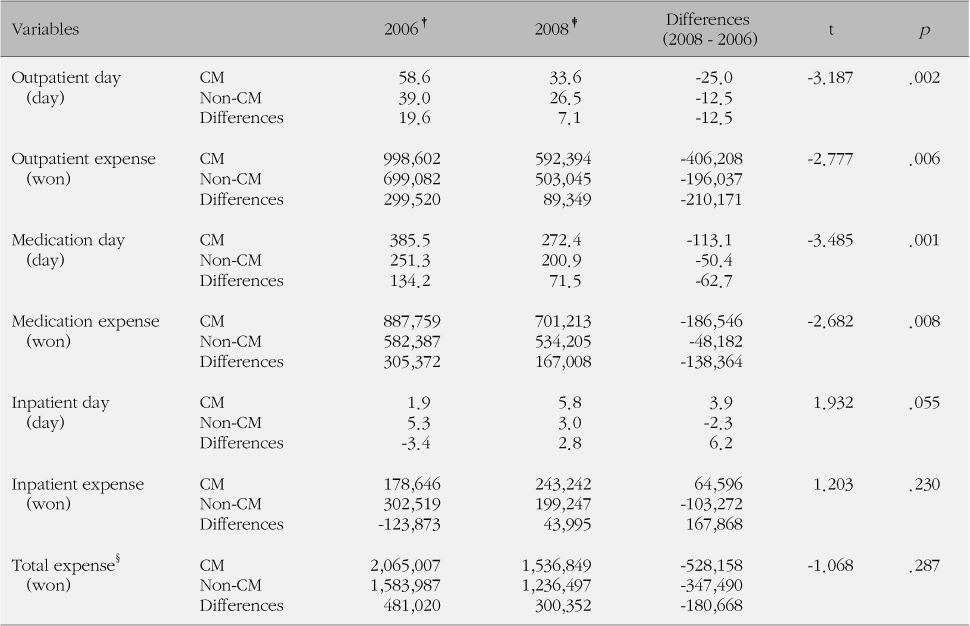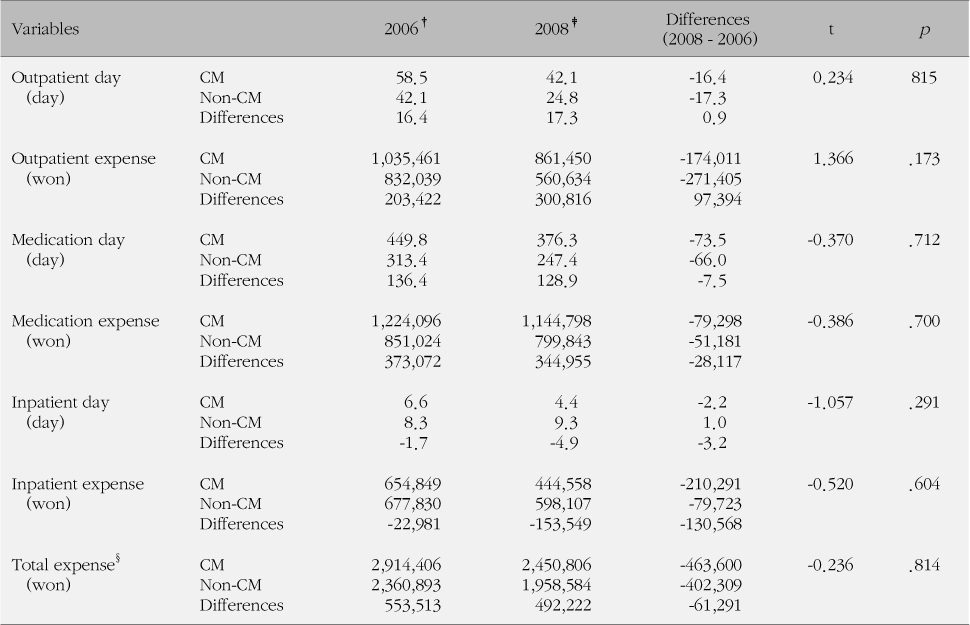Articles
- Page Path
- HOME > J Korean Acad Community Health Nurs > Volume 21(3); 2010 > Article
-
Original Article
- Change in Healthcare Utilization by Disease Severity after Case Management for Medicaid
- Seung Joo Lim
-
Journal of Korean Academy of Community Health Nursing 2014;21(3):321-332.
DOI: https://doi.org/10.12799/jkachn.2010.21.3.321
Published online: April 4, 2014
Part-time Lecturer, College of Nursing, Seoul National University, Korea.
• Received: July 31, 2010 • Revised: September 13, 2010 • Accepted: September 16, 2010
© 2013 Korean Academy of Community Health Nursing
This is an Open Access article distributed under the terms of the Creative Commons Attribution Non-Commercial License (http://creativecommons.org/licenses/by-nc/3.0/) which permits unrestricted non-commercial use, distribution, and reproduction in any medium, provided the original work is properly cited.
- 575 Views
- 2 Download
- 4 Crossref
Abstract
-
Purpose
- This study examined change in healthcare utilization by disease severity after case management (CM) for Medicaid.
-
Methods
- Data were extracted from survey data on "Healthcare utilization and health status of Medicaid beneficiaries" conducted in 2007 and 2008 by the Ministry for Health, Welfare and Family Affairs. This study was designed to compare change in healthcare utilization between the CM group and the non-CM group. The subjects were 528 Type I Medicaid beneficiaries who utilized healthcare more than 365 days during 2006.
-
Results
- In beneficiaries having fewer than 3 among the 11 notified diseases, the CM group showed a significantly larger decrease in outpatient day, outpatient expense, medication day, and medication expense than the non-CM group. In beneficiaries having 3 or more among the 11 notified diseases, however, there was no significant difference in healthcare utilization between the CM group and the non-CM group.
-
Conclusion
- CM worked effectively on Medicaid beneficiaries outpatient healthcare utilization for mild diseases. However, its effects on hospitalization, which is a major cause increasing the total expense, were not observed. Therefore, a future study is needed to develope strategies to reduce hospitalization and care for Medicaid beneficiaries with severe diseases.
Table 1General Characteristics of Beneficiaries having Fewer than 3 and Those having 3 or More among the 11 Notified Diseases (Unit: person)


Table 2Disease Characteristics of Beneficiaries having Fewer than 3 and Those having 3 or More among the 11 Notified Diseases (Unit: person)


Table 3Comparison of Healthcare Utilization between the CM Group and the Non-CM Group in Beneficiaries having Fewer 3 among the 11 Notified Diseases (N=230)


- 1. Boult C, Giddens J, Frey K, Reider L, Novak T. Guided care: A new nurse-physician partnership in chronic care. New York: Springer Publishing Company; 2009.
- 2. Boult C, Reider L, Frey K, Leff B, Boyd CM, Wolff JL, et al. The early effects of "guided care" on the quality of health care for multimorbid older persons: A cluster-randomized controlled trial. J Gerontol A Biol Sci Med Sci. 2008;63(3):321–327. PubMed
- 3. Boyd CM, Shadmi E, Conwell LJ, Griswold M, Leff B, Brager R, et al. A pilot test of the effect of guided care on the quality of primary care experiences for multi-morbid older adults. J Gen Intern Med. 2008;23(5):536–542. ArticlePubMedPMCPDF
- 4. Fitzgerald JF, Smith DM, Martin DK, Freedman JA, Katz BP. A case manager intervention to reduce readmissions. Arch Intern Med. 1994;154(15):1721–1729. ArticlePubMed
- 5. Kim ES, Lee JY, Yu WS, Lee YP, Lim SJ, Cho JH, et al. A direction of case management for medicaid beneficiaries' appropriate utilization: Focusing on long term inpatient. Seoul: Ministry of Health, Welfare and Family Affairs, Korea Human Resource Development Institute for Health and Welfare, & Institute of Case Management for Medicaid; 2009.
- 6. Kim JH. Reevaluation of the demonstration project for DRG payment system: Focusing on the evaluation methodology. Korean Health Econ Review. 2002;8(1):59–89.
- 7. Lee IS, Lee YR, Kang HG. Evaluation of case management for medicaid. Seoul: Ministry of Health & Welfare, & Yonsei University; 2004.
- 8. Mayo PH, Richman J, Harris HW. Results of a program to reduce admissions for adult asthma. Ann Intern Med. 1990;112(11):864–871. ArticlePubMed
- 9. Ministry for Health, Welfare, & Family Affairs. 2008 Guideline of medicaid management. Seoul: Author; 2008a.
- 10. Ministry for Health, Welfare, & Family Affairs. (11-1351000-000038-10). Health, Welfare and Family Affairs. Seoul: Author; 2008b.
- 11. Ministry of Health & Welfare. 2007 Guideline of medicaid management. Seoul: Author; 2007.
- 12. National Assembly Budget Office. 2005 analysis of closing accounts of an annual revenue and expenditure 2006;Retrieved November 8, 2009. from http://www.nabo.go.kr/korea/view/11search/search.jsp
- 13. National Health Insurance Corporation. 2008 Medicaid statistics 2009;Retrieved November 5, 2009. from http://www.nhic.or.kr/wbm/wbmc/wbmc_0400/wbmc_0403/wbmc_0403.html
- 14. Oh JJ, Choi JM, Ji YG. Health services use and health status of medicaid beneficiaries according to medicaid policy change. Seoul: Ministry of Health, Welfare and Family Affairs, Korea Human Resource Development Institute for Health and Welfare, & Dankook University; 2009.
- 15. Park EJ, Kim CM. Case management process identified from experience of nurse case managers. J Korean Acad Nurs. 2008;38(6):789–801. ArticlePubMed
- 16. Powell SK. Case management: A practical guide to success in managed care. 2nd ed. Baltimore: Lippincott Williams & Wilkins; 2000.
- 17. Rhee WH. Developing a case management strategies program for a Korean medical aid clients. Seoul: Hanyang University; 2006. Unpublished doctoral dissertation.
- 18. Rich MW, Beckham V, Wittenberg C, Leven CL, Freedland KE, Carney RM. A multidisciplinary intervention to prevent the readmission of elderly patients with congestive heart failure. N Engl J Med. 1995;333(18):1190–1195. ArticlePubMed
- 19. Riegel B, Carlson B, Kopp Z, LePetri B, Glaser D, Unger A. Effect of a standardized nurse case-management telephone intervention on resource use in patients with chronic heart failure. Arch Intern Med. 2002;162(6):705–712. ArticlePubMed
- 20. Sadur CN, Moline N, Costa M, Michalik D, Mendlowitz D, Roller S, et al. Diabetes management in a health maintenance organization. Diabetes Care. 1999;22(12):2011–2017. PubMed
- 21. Schraeder C, Fraser CW, Clark I, Long B, Shelton P, Waldschmidt V, et al. Evaluation of a primary care nurse case management intervention for chronically ill community dwelling older people. J Clin Nurs. 2008;17(11c):407–417. ArticlePubMed
- 22. Shin YA, Shin HC, Shin HW, Park EJ, Hong SW, Shin SM, et al. Health services use and health status of medicaid beneficiaries according to medicaid policy change. Seoul: Ministry of Health, Welfare and Family Affairs, Korea Human Resource Development Institute for Health and Welfare, & Institute of Case Management for Medicaid; 2008.
- 23. Shin YS, Shin HW, Hwang DK, Rho IC. Monitoring for medicaid financial efficiency (2006-20-1). Seoul: Korea Institute for Health and Social Affairs; 2006.
- 24. Shin YS, Shin HW, Hwang DK. Effectiveness of case management for medicaid I (2007-17-2). Seoul: Korea Institute for Health and Social Affairs; 2007.
- 25. Steffens B. Cost-effective management of type 2 diabetes: Providing quality care in a cost-constrained environment. Am J Manag Care. 2000;6:13 Suppl. S697–S703. PubMed
- 26. Sylvia ML, Griswold M, Dunbar L, Boyd CM, Park M, Boult C. Guided care: Cost and utilization outcomes in a pilot study. Dis Manag. 2008;11(1):29–36. ArticlePubMed
- 27. Taylor CB, Miller NH, Reilly KR, Greenwald G, Cunning D, Deeter A, et al. Evaluation of a nurse-care management system to improve outcomes in patients with complicated diabetes. Diabetes Care. 2003;26(4):1058–1063. ArticlePubMedPDF
- 28. Weinberger M, Oddone EZ, Henderson WG. Does increased access to primary care reduce hospital readmission? N Engl J Med. 1996;334(22):1441–1447. ArticlePubMed
- 29. West JA, Miller NH, Parker KM, Senneca D, Ghandour G, Clark M, et al. A comprehensive management system for heart failure improves clinical outcomes and reduces medical resource utilization. Am J Cardiol. 1997;79(1):58–63. ArticlePubMed
- 30. Yu WS. Outcome and Medium-long term range plan of basic medical security system. Proceedings of Symposium Celebrating the 30th Anniversary of Korea Medicaid Aid Seoul: Ministry of Health & Welfare, National Health Insurance Corporation, Health Insurance Review & Assessment Service, & Korea Human Resource Development Institute for Health and Welfare; 2007.
Figure & Data
References
Citations
Citations to this article as recorded by 

- The Effect of Case Management Services for High-risk Medicaid Beneficiaries
Young Jin Ahn, Yun-Kyoung Choi
Journal of the Korea Academia-Industrial cooperation Society.2015; 16(8): 5430. CrossRef - Comparing the Needs of Case Management between Medical Aid Beneficiaries with Simple and Multiple Chronic Diseases
Yang Heui Ahn, Yeonok Suh, Ok Kyung Ham, Hee Kyung Kim
The Korean Journal of Rehabilitation Nursing.2015; 18(2): 98. CrossRef - Case Management for Medical Aid Beneficiaries in Korea: Findings from Case-control Study
Hee-Sun Shin, Jin-Joo Oh
Asian Nursing Research.2014; 8(4): 274. CrossRef - Multilevel Analysis of Health Care Service Utilization among Medical Aid Beneficiaries in Korea
Yang Heui Ahn, Ok Kyung Ham, Soo Hyun Kim, Chang Gi Park
Journal of Korean Academy of Nursing.2012; 42(7): 928. CrossRef

 KACHN
KACHN

 PubReader
PubReader Cite
Cite

